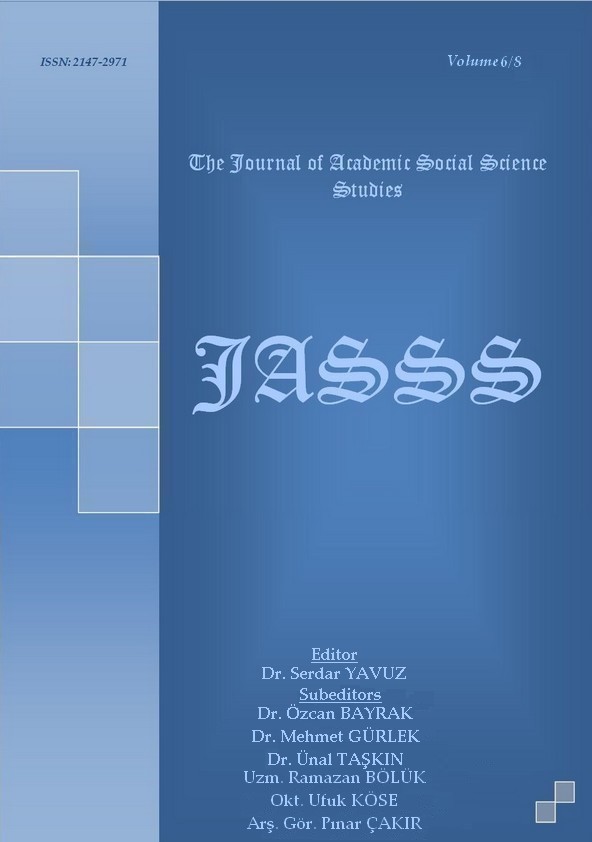Author :
Abstract
Özellikle Yahudi toplumunda anti-semitizm, kimlik ve yabancılaşma konularıyla ilgilenen Philip Roth yirminci yüzyılın en önemli Amerikan-Yahudi yazarlarından biridir. Zuckerman Bound adlı eseri Yahudiler arasında popüler olmayan marjinal romanlara sahip Nathan Zuckerman adlı ünlü bir yazarı konu alır. The Ghost Writer adlı eserinde Zuckerman yaşadığı çevreyi, akrabalarını ve ailesini de karşısına alarak kendine örnek gösterdiği Lonoff gibi romancı olmak niyetindedir. Zuckerman Unbound romanında artık romanı yazmış ünlü bir yazardır. Ancak toplumla olan savaşı başlamıştır. The Anatomy Lesson eserinde ise ebeveynlerinin ölümünden kendisini suçlayan kardeşi ve kendi psikolojisi yaşamını altüst etmiştir. Son romanı Prague Orgy daha ziyade toplumun Yahudi toplumuna ve kültürüne olan bakışı üzerine yoğunlaşmıştır. Zuckerman sadece başka dinlerdeki insanlarla çelişmez ayrıca Yahudi toplumunda da tartışmalı bir isimdir. Gerçekte kaleme aldığı başkahraman Roth’un kendisidir. Aidiyetsizlik ve tabiyetsizlik romanda Zuckerman/Roth’un benliğinde bir sorundur. Örneğin, The Anatomy Lesson adlı romanda Zuckerman “başka birisi dahi olup olamadığını sorgulamak zorunda kalan muhtaç bir hastaya” (Wilson, 2005: 104) dönüşmüştür. Greenberg ise aynı romanı “Zuckerman’ın bir insan ve yazar olarak sınırları zorlaması” (1997) olarak değerlendirir. Her bir romanda okuyucu adaptasyon, yalnızlaşma ve başkahramanın Yahudi Amerikan toplumundaki değişiklikleri bulmaktadır. Ana temalar her ne kadar romandan romana çeşitlilik gösterse de, genel olarak konu başkahramanın psikolojik durumu üstüne kurulmuştur. Roth başkahramanların psikolojik durumlarını da ele alarak insanı ve toplumun bakış açısını irdelemeyi başaran yazarlardandır. Bu çalışmada kendisini şekillendiren Roth/Zuckerman’ın kimlik ve sosyal zorlamaları tartışılacaktır.
Keywords
Abstract
Philip Roth dealing with anti-Semitism, alienation and identity in especially Jewish society is one of the distinguish American-Jewish writers in the twentieth century. Zuckerman Bound consisting of The Ghost Writer, Zuckerman Unbound, The Anatomy Lesson and The Prague Orgy recounts the famous Jewish author Nathan Zuckerman who has marginal novels which are not popular among Jews. Not only does Zuckerman discuss with people in other religion but also he is a controversial person in Jewish society. In fact, Roth depicts himself by penning a protagonist Zuckerman. The feeling of disorientation and statelessness rise in Zuckerman/Roth mind in four novels. For example in Anatomy Lesson, Zuckerman becomes "a helpless patient who is compelled to ask himself whether or not he can even become someone different" (Wilson, 2005: 104). Also Greenberg depicts the same novel as "Zuckerman's involvement with transgression as a man and a writer" (1997). In each novel, the reader can find the attempts of adaptation, isolation and how the protagonist alters in both Jewish and American society. Even though the themes dealt with differ from each novel, by and large, the plot is predicated on the protagonist’s psychology. In this study, Roth / Zuckerman' s identity and the social constraints shaping them will be argued.
Keywords
- ALTER, R. (1986). “The Jew Who Didn't Get Away: On the Possibility of an American Jewish Culture” The American Jewish Experience ed. Jonathan D. Sarna, New York: Holmes & Meier p.269-283
- BERNSTEIN, J. (2003). “Melancholy As Form: Towards An Archaeology Of Modernism” The New Aestheticism eds. John J. Joughin - Simon Malpas, Manchester: Manchester University Press p. 167-190
- BUDICK, E. M. (2003). “The Holocaust in the Jewish American literary imagination” The Cambridge Companion to Jewish American Literature eds.hana Wirth-Nesher Michael P. Kramer Cambridge: Cambridge University Press p.212-231
- GREENBERG, R. M. (1997). “Transgression in the Fiction of Philip Roth” Twentieth Century Literature 43/4 pp. 487-506
- HARAP, L. (1987). “Confessions of Philip Roth” In the Mainstream: The Jewish Presence in Twentieth-Century American Literature, 1950s-1980s. New York: Greenwood Press
- KAUFMAN, W. (2009). American Culture in the 1970s. Edinburgh: Edinburgh University
- KAUVAR, E. M. (2005). “Philip Roth: A Heart with Dichotomies Up Society's Ass, Copper: Rereading Philip Roth by Mark Shechner; Philip Roth: Countertexts, Counterlives by Debra Shostak” Contemporary Literature,46/4 p. 720-735
- MILLER, K. (1989). Authors Oxford: Clarendon Press
- OSTER, J. (1998). “See(k)ing the Self: Mirrors and Mirroring in Bicultural Texts” MELUS 23/4 p. 59-83
- PARRISH, T. L. (2000) “The End of Identity: Philip Roth's American Pastoral” Shofar 19/1 Acc. Date 10.04.2013 http://www.questia.com/read/1G1-13472298
- POSNOCK, R. (2006). Philip Roth's Rude Truth: The Art of Immaturity Princeton: Princeton University Press.
- RAVVIN, N. (1997). A House of Words: Jewish Writing, Identity, and Memory Montreal: McGill-Queens University Press
- ROBERTS, N. R. (2000). “Bobbie Ann Mason and Philip Roth: Two Great-American- Novel Concepts Pieced in One Big Picture1” Shofar 19/1 Acc. Date: 01.04.2013 http://www.questia.com/read/1P3-1742023091/
- ROTH, P. (1985). Zuckerman Bound New York: Farrar Straus Giroux
- ROYAL, D. P. (2000). “Texts, Lives, and Bellybuttons: Philip Roth's Operation Shylock and the Renegotiation of Subjectivity” Shofar 19/1 Acc. Date:01.04.2013 http://www.questia.com/read/1P3-1742023051
- SHECHNER, M. (1989). “Zuckerman's Travels” American Literary History 1/1 pp. 219-
- SEARLES, G. J. (1985). The Fiction of Philip Roth and John Updike. Illinois: Southern Illinois University Press
- SHOSTAK, D. (2000). “Philip Roth's Fictions of Self-Exposure” Shofar 19/1 Acc. Date: 01.04.2012 http://www.questia.com/read/1P3-1742023031
- STANLEY, S. K. (2005). “Mourning the "Greatest Generation": Myth and History in Philip Roth's American Pastoral” Twentieth Century Literature 51/1 Acc. Date:01.04.2013 http://www.questia.com/read/1G1-13472292
- STONEHILL, B. (1988). The Self-Conscious Novel:Artifice in Fiction from Joyce to Pynchon. Philadelphia: University of Pennsylvania Press
- WIRTH-NESHER, H. “1991). “The Counterlife: Israeli Perspectives on American Literature” As Others Read Us: International Perspectives on American Literature ed. Huck Gutman Amherst: University of Massachusetts Press p. 131-147





